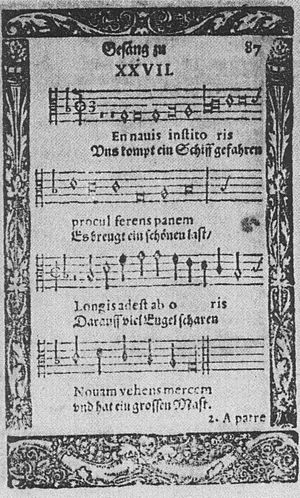Es kommt ein Schiff, geladen facts for kids
Quick facts for kids "Es kommt ein Schiff, geladen" |
|
|---|---|
| Advent song | |

"Uns kompt ein Schiff gefahren", Andernacher Gesangbuch, Cologne 1608, oldest evidence of the song
|
|
| Written | before 1450 |
| Text | Johannes Tauler? |
| Language | German |
| Published | 1608 |
"Es kommt ein Schiff, geladen" means "A ship is coming, laden." It is an old German song sung during the Advent season, which is the time leading up to Christmas. It is also a Marian Hymn, meaning it is a song about Mary, the mother of Jesus. This song is one of the oldest religious songs from Germany.
The Song's History
The oldest known copy of the song's words was found in a handwritten book from before 1450. This book was discovered in a Dominican convent (a type of religious house) in Strasbourg.
People believe that Johannes Tauler, a mystic (someone who thinks deeply about spiritual things), might have written the words. He often visited that convent. One reason for this idea is a special word he used a lot, which also appears in the song.
What the Ship Means
The song uses an allegory. This is like a story or image that represents a deeper meaning. In this song, the "loaded ship" is a symbol for Mary when she is pregnant with Jesus.
The song says the ship moves quietly. Its sail stands for love, and its mast stands for the Holy Spirit. This shows how Mary, full of love and guided by the Holy Spirit, carries Jesus into the world.
The oldest music for this song was printed in a book called Andernacher Hymns in 1608. In that book, the song appeared with both German and Latin words.
Song Lyrics
Here are the words to "Es kommt ein Schiff, geladen" in both German and English:
|
Es kommt ein Schiff, geladen |
There comes a galley, laden |
The Melody
Here is the musical notation for the song's melody: <score sound raw> \header { tagline = ##f } \layout { indent = 0\cm \set Score.tempoHideNote = ##t \context { \Score \remove "Bar_number_engraver" } \context { \Voice \remove "Dynamic_engraver" } }
global = { \key d \minor \time 6/4 \partial 4 }
soprano = \relative c { \global a4^\mf | a2 a4 c2 c4 | d2. d2 a4 | bes2 bes4 g2 g4 \time 4/4 | a2 r4^\ff \tempo 4=108 f4^\markup { \italic "c.f." } | a c d d | c8 (bes a g) f4 g | a g f e | d2. \bar "|." }
alto = \relative c' { \global d4_\mf | d2 d4 g2 g4 | a2 (g4) f2 e4 | d2 d4 d2 c4 \time 4/4 | c2 r4 c4 | f f f f | c2 d4 e | f c d c | d2. \bar "|." }
tenor = \relative c { \global d4_\ff^\markup { \italic "c.f." } | d2 d4 e2 e4 | f (g a) a2 a4 | g2 g4 d2 e4 \time 4/4 | f2 r4 a_\mf | c c bes bes | a2 a4 c c c a a | <a fis>2._\pp \bar "|." }
bass = \relative c { \global d4_\mf | d2 d4 d2 d4 | d2. d2 c4 | bes2 bes4 bes2 c4 \time 4/4 | f2 r4 f4 | f e d bes | f'4. (e8) d4 c | f e d a' | d2. \bar "|." }
verse = \lyricmode { Es kommt ein Schiff, ge -- la -- den bis an sein höch -- sten Bord, trägt Got -- tes Sohn voll Gna -- den, des Va -- ters e -- wigs Wort. }
\score { \new ChoirStaff << \new Staff \with { midiInstrument = "trumpet" \consists "Merge_rests_engraver" } << \new Voice = "soprano" { \voiceOne \soprano } \new Voice = "alto" { \voiceTwo \alto } >> \new Lyrics \lyricsto "soprano" \verse \new Staff \with { midiInstrument = "trombone" \consists "Merge_rests_engraver" } << \clef bass \new Voice = "tenor" { \voiceOne \tenor } \new Voice = "bass" { \voiceTwo \bass } >> >> \layout { } \midi { \tempo 4=120 } } </score>
- c.f. = cantus firmus (This means "fixed song" or "main melody." It's a melody that stays the same while other parts of the music change around it.)
Musical Adaptations
The famous composer Max Reger used this song's tune in some of his organ pieces. You can find it in his collection called Sieben Stücke, Op. 145.


